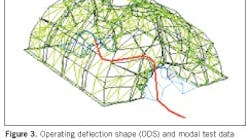A power plant in Asia was experiencing high vibration and cracking in the exhaust hood of a critical large low-pressure steam turbine (Fig. 1). The typical troubleshooting approach Mechanical Solutions Inc. (MSI, www.mechsol.com) uses in such situations is to travel to the site of the machinery, collect the data, analyze it and recommend a fix. However, in this case, such a trip might have jeopardized company personnel in an area where insurgents and bird flu were threatening, so a remote problem-solving approach was implemented.
Data acquisition hardware and a large amount of instrumentation was prepped and shipped to the jobsite, with proper export licensing and paperwork filed consistent with U.S. State Department and ITAR controls. The equipment included a large number of accelerometers, pressure transducers, strain gages and a modally tuned impact hammer. An Internet Protocol (IP) telephone and camera also were included to facilitate inexpensive verbal and visual real-time communication between the expert engineers in the United States and the plant personnel in Asia. The plant’s local personnel installed the instrumentation under MSI’s careful oversight from 12,000 miles away.
MSI’s troubleshooting process was carried out step by step, with the local plant personnel acting as MSI’s hands and legs at the site. Visual and voice communication were continuous to avoid misunderstandings despite the distance and language difference. MSI staff controlled a 40-channel FFT analyzer and a 16-channel strain gage amplifier and recorder remotely over the broadband Internet connection, available through a high-speed satellite intermediary.
Remotely collected data were immediately compared with theoretical results provided by finite element analysis (FEA) performed at MSI’s U.S. offices. Assumptions about boundary conditions, flange-to-flange stiffness and dynamic loads were confirmed or adjusted until the theoretical predictions matched the actual behavior. The resulting analysis was calibrated with reality in this manner, and then was used with confidence to evaluate potential fixes.
The remote test data on the exterior of the machine, and on the shaft within the bearing housings, were extrapolated from the locations where data acquisition was feasible, to zones inside the machine where it was impractical to locate data probes. This is a form of noncontact stress-measurement system (NSMS) that MSI pioneered in government research projects during recent years. The approach determined behavior of the complete (not just the exposed) turbine rotor, and revealed how rotor motion coordinated with structural motion.
The combined test and analysis model identified a dangerous, running-speed resonance of a natural frequency of the exhaust hood that involved synchronous motion at both ends close to the turbine operating speed. It furthermore proved that the structural natural frequency coupled with an S-shaped rotor natural frequency that was supposed to be comfortably above running speed, but instead was resonant, causing a feedback relationship that led to enough motion to crack the casing at the problem locations.
Figure 2 shows the motion of the natural frequency combination. A mistake in the alignment between the turbine and generator, which would have normally resulted in minor vibration increase, was driving the rotor mode, which, in turn, was driving the bearing housing, which drove the exhaust hood casing motion. The swaying structural motion reinforced the rotor second bending (S-shaped) mode shape, completing the dangerous cycle.
The ends of the exhaust hood were stiffened with thick, bolt-on support ribs, and thick metal plating across the casing ends. The vibration was dramatically reduced, and the cracking stopped for the first time in several years. Costly trial-and-error problem-solving was avoided by the rapid-response and low-cost approach, allowing the plant to get back to what it does best: producing megawatts for an electric-power-hungry region of the world.


